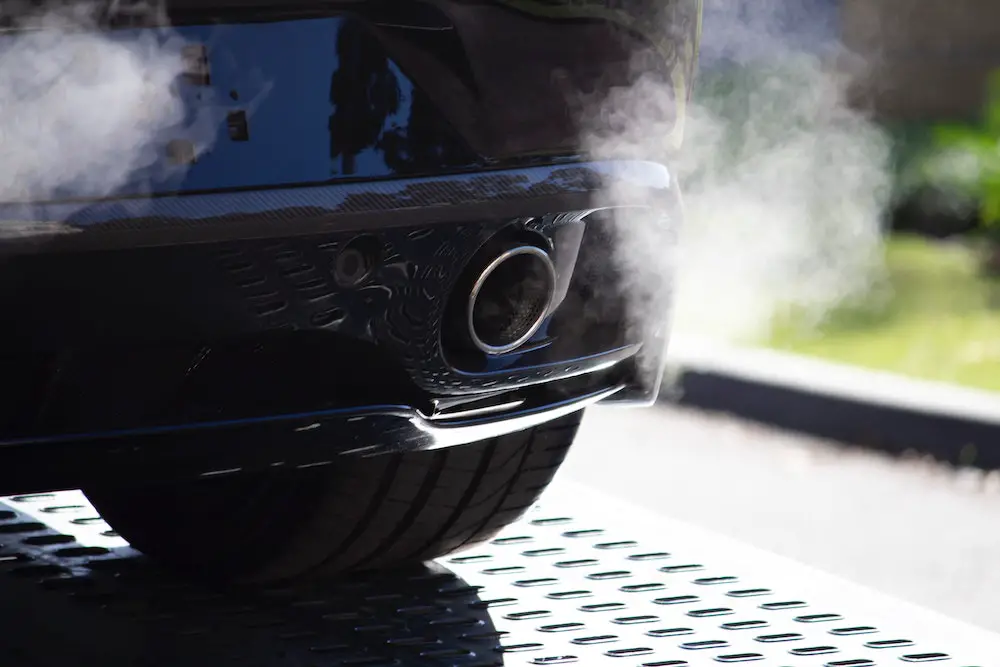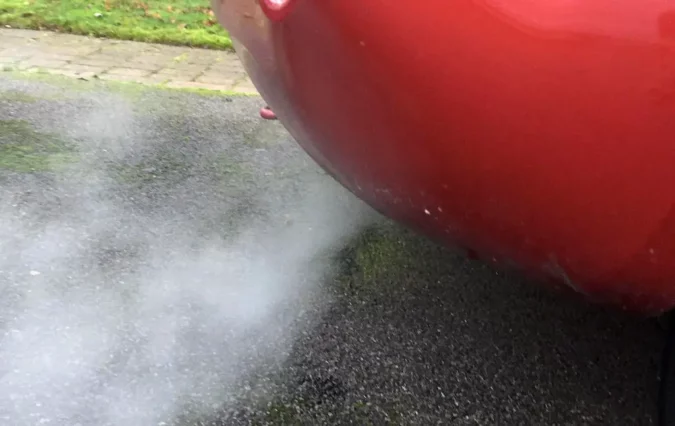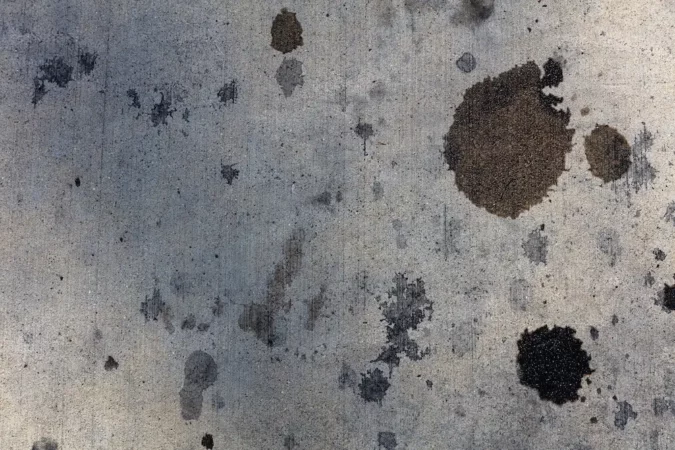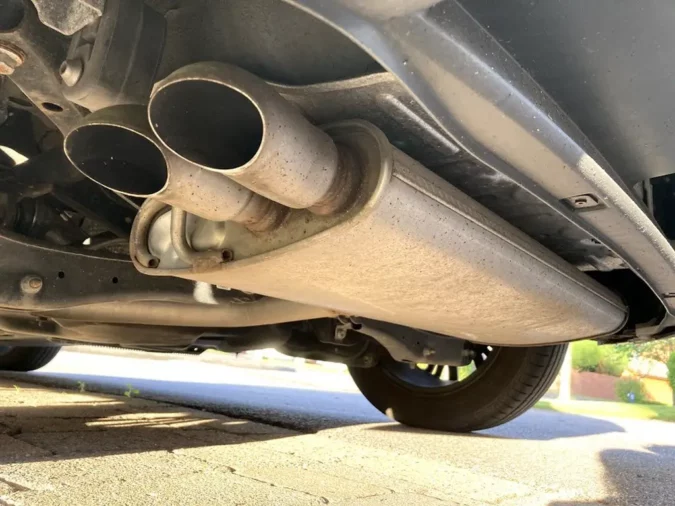When it comes to driving, certain colors are understood. Green denotes “go.” Yellow denotes “caution”. Red indicates “stop.” What does it imply then if your car’s exhaust starts to change colors when traffic signals are intended to change color? What is blue smoke from exhaust?
It could indicate something is wrong and needs to be investigated, or it could imply nothing. Before your next drive “goes up in smoke,” check out the automobile exhaust color coding below to see if it’s time for an oil leak repair, an engine tune-up, a coolant check, or anything more serious.
- What does Smoke Color Means?
- Causes of Blue Smoke?
- How to Diagnose it?
- How to Fix it?
- Lawn Mower Blue Smoke?
- Cost of Repair?
- FAQs
- Final Verdict
Exhaust Smoke Colors
White Smoke From Exhaust
The most typical type of exhaust smoke isn’t even smoke at all. When a cold engine is started, it quickly starts to heat up and produces water vapor as a byproduct. As a result, condensation forms in the exhaust system, which later transforms into steam as engine temperatures rise. It’s just water coming out of the exhaust while idling.
Once an automobile warms up, the steam quickly disappears. However, issues might arise if a car is only used for short distances, which prevents the exhaust system from warming up all the way to the exhaust tip. Or, if you notice white smoke coming from the engine.
The naked steel of the exhaust can corrode if dew builds up inside the system and doesn’t evaporate, leading to rust that could eventually cause an exhaust leak (note the sound) and blowing from the system, which is where exhaust gases escape. The inaccurate emissions test results could result in an vehicle inspections failure.
However, this is also unimportant because it is really a postponed response to the same heating process described above. Even though it is steamy, thicker and persistent white smoke from the exhaust (including on startup) indicates that your car’s coolant is seeping into the engine and could lead to more serious problems.
Another possible reason is that while the exhaust was being topped off, some oil may have leaked onto it, only to be heated and burned off while you were driving by the hot exhaust.
Blue Smoke From Exhaust
When blue smoke appears in a vehicle with high mileage, it may be a sign that the piston rings or valve seals are worn, allowing oil to enter the fuel system near the cylinders or valves.
This can be fixed by installing new seals all around, but as you may think, this is expensive because it requires disassembling the engine to reach the seals. It is worthwhile to check the dipstick more frequently to determine how much oil loss occurs because the car is burning oil will also indicate that you are using more oil than usual.
As long as the oil loss doesn’t worsen, topping up with oil will be easier than repairing if the issue is mild. A worn-out turbocharger may also be the cause of blue smoke coming from a turbocharged vehicle. This will require reconstruction or replacement, which is a costly task.
Grey Smoke From An Exhaust
Grey smoke, like blue smoke, may indicate that there is too much oil burning in the engine or that the turbo needs to be repaired, but there are other causes as well. One of these could be among the symptoms of a bad PCV valve.
Positive crankcase ventilation, or PCV, is one of the most fundamental types of pollution management because it moves unburned fuel from the bottom of the engine to the top. Particularly when the engine is cold, this helps minimize vehicle emissions, although it may eventually wear out.
When compared to some of the other causes on this list, PCV repair is a very simple task, despite the alarming appearance of the smoke created by PCV failure. Grey smoke may also be caused by transmission fluid entering the engine through a leak if you operate an automatic transmission vehicle.
Again, this could be a pricey repair, so a garage will undoubtedly need to handle it.
Black Smoke From An Exhaust
Various things can cause black exhaust smoke, and one of the key things to consider is whether your car is driven by gasoline or diesel. Black smoke from a gasoline vehicle indicates that too much fuel is being burned.
To fix this, check or replace your car’s air filter first. It should be easy to find but consult your owner’s manual if you’re unsure. If everything is in order, the next step is to see if the fuel injectors are blocked and the fuel pressure regulator is clean; however, a professional should perform this task.
Soot buildup from unburned diesel may be the root of black smoke in diesel vehicles. If you only ever drive a diesel car at modest speeds, the soot deposits can accumulate over time and may cause a dashboard warning light to flash.
The diesel particulate filter (DPF) is meant to catch particles from unburned diesel before it pumps out of the car’s exhaust. The best line of action is to drive the automobile quicker to increase the fuel/air combination flow through the engine.
Find a highway nearby and quickly accelerate your diesel automobile to 70 mph; this should expel the soot, manifesting as a ball of black smoke behind the vehicle and potentially leaving soot deposits on the road as well.
Blue Smoke From Exhaust Causes
There are several causes for the blue smoke that comes from the exhaust. In this article, we separate these causes into two categories: blue exhaust smoke when the engine is starting and blue exhaust smoke when the engine is accelerating.
1. Blue Smoke From Exhaust When Starting (Not Diesel)
If your car’s engine is not a diesel and you notice blue smoke coming out of the exhaust after you have parked it for a long, bad valve seals are likely to blame. There are valves in every engine that open and close. It’s among the most common symptoms of bad valve seals.
Thus, requiring you to consider the cost of a replacement valve seals. These valves are designed to operate mechanically when a rocker arm applies pressure. They opened the engine’s fuel and air intake. They also let the exhaust gas out of the engine once the mixture of air and gasoline has burned.
Where the rocker arm exerts pressure on the valves, oil coats the top of the valves. To stop this oil from entering the engine, there are valve seals. The oil will enter the engine if these valves are worn or damaged, where it will burn with the gasoline and air to produce blue smoke.
2. Blue Smoke With A Diesel Engine
We need to use a glow plug to ignite diesel fuel when starting a diesel engine. Once the engine has warmed up, the glow plug is not required because the engine’s heat will cause diesel fuel to ignite (which might factor in with why is diesel so expensive). When a diesel engine is started with a damaged diesel glow plugs, blue smoke will be produced until the engine has warmed up.
What Causes Blue Smoke From Exhaust When Accelerating
1. A Clogged PVC Valve
The PCV valve should be checked first if you frequently notice blue smoke coming from your car. The PCV valve aims to release the pressure into the intake manifold that accumulates in the oil pan.
Your engine’s air filter and intake manifold are connected. Therefore, if the PCV valve becomes stuck, the engine’s oil, air, and other gases will continue to combine. This mixture will burn and produce blue smoke.
2. Damaged Engine
Another cause of the blue exhaust smoke is a worn engine. Pistons in each engine can move up and down a cylinder. Metal rings that resemble bracelets surround each piston’s side.
These rings’ purpose is to assist the piston in creating a secure seal with the cylinder. Oil rises from beneath the piston if the rings or cylinder are worn out. Blue smoke is produced when the oil is burned after being combined with the air and gasoline.
3. Blown Turbo
A blown turbo most likely causes blue smoke in turbo cars. If your car bursts a turbo, a large cloud of blue smoke will emerge out of nowhere. A blown turbo is either caused by damage to the turbo casing or a ruptured oil seal. They allowed oil into the engine’s intake in both instances.
4. Transmission Fluid Loss
In earlier cars with vacuum-controlled automatic gearboxes, the transmission shift is managed by a modulator. Any modulator issue, such as a faulty diaphragm, allows the engine to suck up the transmission fluid. The blue smoke flowing from the exhaust will then be produced when this transmission fluid is burned like oil.
Diagnosing Blue Smoke From Exhaust
Blue exhaust smoke diagnostic methods are rather simple, and a skilled technician may finish them quickly. What your technician will do is as follows:
Step 1: Check The Head Gasket
A burst or blown head gasket most frequently causes blue exhaust smoke. Coolant fluid under the car, an overheated engine, milk-colored engine oil (this is what happens when there’s oil in the coolant), and poor performance are warning indications and common symptoms of a blown head gasket.
A mechanic will lift the oil filler cap as an additional assurance measure in addition to the warning indications stated previously. If the head gasket is compromised, the cap will be covered in a milky brownish-yellow coolant mixture.
Step 2: Check For Engine Oil Leaks
A mechanic will use a dipstick to check the oil level in the car. They’ll look under the car for any obvious car oil leak if the engine oil is low.
If a leak is discovered, the mechanic will do more testing to determine which components may require replacement or repair. Engine oil leaks are typically caused by worn piston rings, valve seals, or engine oil seals (valve stem steals).
Step 3: Inspection Of The Valve Seal And Piston Ring
Faulty piston rings and valve seals can leak engine oil. Fortunately, it’s easy to understand. Valve seals are at blame if your exhaust system only briefly emits blue smoke after the engine begins. You have damaged piston rings if the smoke continues after the engine has started.
Step 4: Examine The PCV Valves
The PCV valve normally connects to a tube or hose and is fastened to the valve cover. The PCV valve must only be removed and diagnosed by a mechanic. The valve is still functional if they hear a metallic rattling sound.
However, if no sound comes from the PCV valve’s inside, it has seized and is no longer working properly. By immersing a PCV valve in a carb cleaner, you might be able to clean it. Though it’s frequently advisable to replace it.
Step 5: Examine The Transmission Module
A mechanic will initially check the transmission fluid level before testing the module. The transmission fluid level should be checked again if it is noticeably low. The mechanic will gently accelerate the vehicle from a complete stop until it reaches about 25 mph.
They can determine whether the transmission module has failed based on the engine sound, how quickly the transmission shifts gears, and the RPMs.
Step 6: Examine The Turbocharger
Visual examination of the turbo’s case enables quick detection of any damage. Additional mechanical indications of a harmed or failed turbo include:
- Car performing poorly
- Check engine light is on
- Exhaust blue smoke
How To Fix Blue Smoke From Exhaust
1. Drain Extra Oil
As previously noted, oil issues are one of the causes of blue smoke coming from autos. Therefore, the best way to solve this issue quickly is to modify the amount of oil inside the car.
You must first drain any extra oil to avoid harming the pipes with too much pressure or raising the possibility of leaks. Aeration and pressure increase is more likely to happen with more extra oil. If too much oil is added, it won’t have enough room to circulate.
Aeration results from the extra oil mixing with the air while the shaft rotates while the engine runs. Air bubbles in the oil will diminish its ability to lubricate, thus increasing heat. It will eventually cause harm to the engine’s components.
Additionally, too much oil can increase the pressure inside the engine and eventually leak out through various seals and rings. Leaks and pricey repairs will result if one or more of them fail.
These two occurrences combine to make it more difficult for the engine to handle heat and friction better. To address this issue, drain the extra oil and keep what is necessary at the required amount. Additionally, eliminating extra oil can assist in removing outdated fluid that no longer effectively shields components from friction.
2. Clean The Motor
Without routine cleaning and maintenance, engines quickly deteriorate, eventually developing leaks and emitting blue smoke. This issue will be considerably avoided or even resolved with regular general maintenance and engine cleaning.
3. Change Damaged Piston Rings
If the piston rings are worn, the engine’s lubricating oil will leak into the combustion chamber and burn, lowering engine performance and producing blue smoke in the exhaust.
Therefore, piston rings guarantee that joints are sealed, prevent oil leakage, and have a variety of additional functions and advantages. As a result, it’s important to inspect, remove, and swap out any broken rings for new ones.
4. Change The Fresh PCV Valve
A clogged or stuck PCV valve will prohibit air from entering the intake manifold and being vented to the outside because it is a crucial component of the exhaust system. Therefore, taking the car to the repair and maintenance center is vital to install the new valve when you see indicators of a damaged PCV valve that needs replacement.
Lawn Mower Blue Smoke
It can be alarming to see blue smoke coming from your lawnmower. This is particularly true if you have never dealt with it before or if you don’t consider yourself an expert at fixing things. The good news is that it’s most likely a straightforward problem.
The most common cause of blue smoke emanating from a lawn mower is too much oil being burned. The blue smoke should go away after 10 to 15 minutes of patience. Most likely, all you have to do is wait for the additional oil to burn out.
Cost Of Repair
Depending on where in the car system the issue originates from, the cost to fix blue smoke will vary. If you’re lucky, all you’ll need to do is swap out the $40 valve cushions and a few manipulating tools. If you are unsure of your abilities, it will cost you between $100 and $600 to have it inspected and replaced by a competent shop.
In the worst situation, the piston ring of the car will be harmed, and the piston rings replacement cost will be $1000. Accessing this area is frequently challenging, and fear of repair will require disassembling the complete engine block. You may occasionally even need to replace your engine, which might cost up to $7000 or more.
Frequently Asked Questions
Why Is My Car Smoking
Overheating in automobile engines frequently results in smoke. Faulty wire casings, hot engine block residues, and hot fluids like oil, transmission fluid, and brake fluid can cause this. Your cooling system can also be broken, or your engine might not have enough lubricant.
What Does White Smoke From Exhaust Mean
It typically indicates that coolant is being burnt in the engine, indicating a serious problem. A burst head gasket is the most frequent cause of this, and it can easily result in an overheated engine.
What Causes White Smoke From Exhaust
Steam from condensation in the exhaust pipe or a more serious problem brought on by an engine coolant leak could be the source of this. White smoke in excess could be a sign of a failing head gasket.
What Causes A Car To Burn Oil
Wearing piston rings, guides, and seals are other common causes of burning oil since they can let it seep into combustion chambers.
What Does Rolling Coal Mean
Rolling coal is the process of altering a diesel engine to generate copious volumes of sooty, black, or grey exhaust gasses made of unburned diesel fuel. Despite being illegal, it is mostly a North American phenomenon. An example of anti-environmentalism is the rolling of coal.
Why Is My Car Smoking From The Back
This indicates that either the intake valves don’t allow enough air into the engine or the fuel injectors are supplying too much fuel. A malfunctioning fuel pressure regulator, a leaky fuel injector, or a clogged air filter might bring this on. Your engine running this richly can lead to significant issues.
What Does Blue Smoke From Exhaust Mean
Initially, blue smoke can frequently appear to be grey smoke. However, if you observe it, a pronounced bluish hue could indicate that the engine is burning a lot of oil. This can result from worn engine parts like PCV (Positive Crankcase Ventilation) valves, PCV seals, or piston rings.
Why Is My Engine Smoking
Overheating in automobile engines frequently results in smoke. This can be caused by faulty wire casings, hot engine block residues, and hot fluids like oil, transmission fluid, and brake fluid. Your cooling system can also be broken, or your engine might not have enough lubricant.
How Much Oil Can A Bad PCV Valve Burn
Your vehicle won’t burn oil if your PCV valve is malfunctioning. In fact, you will likely be losing some crankcase oil into the intake manifold and, ultimately, into the combustion chamber if you leak into the PCV system.
What Does Black Smoke From Exhaust Mean
Typically, billowing black smoke indicates that your engine’s fuel-to-air ratio is excessively rich. This indicates that either the intake valves aren’t allowing enough air into the engine or that the fuel injectors are supplying too much fuel. A malfunctioning fuel pressure regulator, a leaky fuel injector, or a clogged air filter might bring this on.
What Causes Black Exhaust Smoke
Numerous factors, such as insufficient combustion, harmed piston rings, a broken fuel pressure regulator, and a blocked air filter, can result in black smoke coming out of exhaust. Diagnosing and fixing exhaust smoke color can be challenging, especially if you’re not an auto specialist or licenced mechanic. However, the issue shouldn’t go unattended.
Can Too Much Oil Cause White Smoke From Exhaust
When you drive your car and notice a lot of thick, white exhaust smoke, the engine block may be burning too much oil; however, other fluids like antifreeze could also be to blame.
How To Stop Car From Burning Oil
A high-mileage synthetic oil is the best option for a car that burns oil. Specific additives found in high-mileage oil halt leaking piston rings and restore a tight seal. These compounds in the high-mileage oil also aid with rust and other issues with aged engines like oil sludge.
How To Get Rid Of Blue Smoke From Exhaust
Remove the valve cover first, then clean your engine as needed to get rid of any debris. Despite the many different types of engines, the engine is unquestionably the first thing that can result in blue smoke. Carefully clean the drain back holes, then examine, inspect, and reassemble them. Wait two to four more days after the repair is complete for the last of the oils to go.
What Causes Blue Smoke From Exhaust
Blue or grey exhaust smoke indicates that your engine is burning oil and that there is probably an oil leak. It’s time to call in a skilled expert to look things over. Numerous problems, including leaking valve seals, worn cylinder walls, and fractured piston rings, could be to blame for the leak.
How To Fix Blow By
Sometimes insufficient lubrication can cause blowby. FTC Decarbonizer can be added right along with diesel. Use Flushing Oil Concentrate when changing your oil. To fix engine blow-by, you essentially just drive the engine clean after adding FTC Decarbonizer to the diesel at each fill.
Final Verdict
Do you ever notice blue smoke from exhaust? Do you understand what it could mean? You’ve come to the correct place if you want to learn more about the possible reasons of blue smoke coming out of exhaust and the best ways to deal with the problem before it gets worse.
If you notice blue smoke coming out of exhaust, your engine may be burning oil. Faulty fuel injectors, a dirty air filter, or worn piston rings may bring this on. While black smoke typically results from dirty fuel injectors or an air filter, white smoke typically signals a coolant leak.
In the end, if you have concerns about the condition of your car, you should seek professional advice. Regular maintenance (and learning how to reset maintenance light on Toyota Corolla), oil changes, or engine fixing can resolve the issue.




